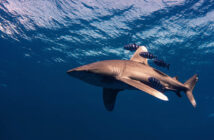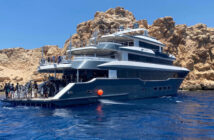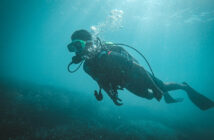I first dived the Red Sea back in 1974 with my very good friend Harry Simmonds on a marine biological course headed by Dr.Paul Cragg (a contemporary of my good friend Prof. David Bellamy), I had a loan of a Nikonos II underwater camera with no clue whatsoever on how it worked, but Jim Wlimot, Pete Bignel and Kevin Cullimore soon set me straight! I had picked up a Nikonos guide book by Jim & Cathy Church to read on the ‘plane to Eilat and took three rolls of 35mm film on our two week trip!
This first trip spurred me to start leading safaris through the Sinai Peninsula from Eilat in Israel (remember that the Sinai was controlled by Israel after the Six Day War in June 1967). These expeditionary safaris took in all of the Eastern Sinai Peninsula when there was no development whatsoever. There was only one hotel: The Marina Sharm Hotel; only three dive businesses in Na’ama Bay: Red Sea Divers run by Howard Rosenstein; Aquanaut owned and operated by Rolph & Petra Schmidt and Aquamarine with Alain Sobol and Claude Antoine; no construction at all and hardly any roads, except for the main road from Eilat to Sharm and a very poor track up to Suez via El Tur and on to Cairo.
Utilising small Bedouin encampments and fishing huts and carting all of our needs: sleeping bags; food, water, soft drinks, harder drinks when required!, air tanks, weights and air compressor, for a week or two of sleeping rough, diving unexplored coastal reefs in an area which was virtually uninhabited. We dived the legendary Blue Hole at Dahab; Nuweiba; Ras Nasrani and Ras Um Sid. Under the control of Israel until 1979, I ran one of the last safari trips into the Sinai and was part of the expat community who were politely asked to leave the Sinai. All businesses were shut down, many structures and schools were destroyed; Israel evacuated the Sinai and the reefs of the Red Sea remained undived for almost two years. Whilst open trade negotiations between Egypt and Israel resumed in 1980, it would be another couple of years before any commercial development started to take place and I was invited by Bruce Lyons of Twickenham Travel dive holiday company to accompany the first live-aboard dive boat, the Lady Jenny III, into the Red Sea to show the new crew where to go, help map new diving sites, explore the reefs and wrecks and open the area up once more for mass diving tourism.
Living in the Red Sea between 1982 and 1986 and of course returning yearly since those early days, I was part of a group of people to witness a number of ships running aground on reefs (including myself) and discovered the identity of an unknown shipwreck at the time (The Carnatic). Whilst not directly involved in the formation of the first Egyptian marine park at Ras Muhammad, my audio visual slide shows so inspired the Minister in charge that I was asked to present a special show for a few of the very highest dignitaries of the country in the Marina Sharm Hotel in Na’ama Bay. It was from these early presentations that the marine park grew and was officially sanctioned in 1983.
Those first exploratory dive trips took the Lady Jenny III and then the Lady Jenny V down the Gulfs of Aquaba and Suez, through the Straits of Tiran, east past Tiran Island on to Sanafir and even Shusha in Saudi Arabian waters. Dive sites were named, shipwrecks discovered, identified and named and sites such as the Alternatives soon became extremely popular in their own right. (The Alternatives were so named as the ‘alternative’ site to dive when Ras Muhammad was blown out by bad weather or when the currents were too strong to dive safely). We were the first divers to explore what would be later discovered to be the Kingston on the northwest shore of Shag Rock. We already knew the name of the Dunraven on Sha’ab Ali (despite a BBC film being made about the ‘discovery’ of the ship after we already knew its name!) and were amongst some of the first divers to visit the Brothers and dive those fabulous reefs and her two superb shipwrecks, the Numidia and the Aïda. Little known naval wrecks sunk during the Six Day War, old submarine nets, curious phenomenon in Marsa Bureika, unknown reefs, lagoons with permanent populations of wild dolphins and dugong, incredible shipwrecks, caves, caverns, historical ancient sites littered with amphora and fish, simply tons of fish. These reefs were the dive boat’s hunting ground and I was very proud to be part of the ground-breaking exploration of the northern Red Sea.
I guess that you could say that the rest is history, and now with over 50 books published and having made photographic history by becoming the first person to gain Fellowships in both the Royal Photographic Society and British Institute of Professional Photographers solely for underwater photography, my underwater travels have taken me all around our watery world to write and illustrate books and magazine features..
I guess that you could say that I am as qualified as anyone to write a guide to the Red Sea, and knowing my history and personal links with the region, my publisher John Beaufoy whom I had worked with for many years, asked if I was interested in producing a small handy sized guide to the northern Red Sea.
This Underwater Guide to the Red Sea offers the best diving and snorkelling to be found in the northern Red Sea but equally as important is the Marine Life Identification section which fills over half of the guide. This guide is an easy ready-reckoner of all the usual suspects, plus a few of the more exotic critters that you may not usually find. However with around 1000 types of invertebrates and 200 species of hard and soft corals and over 1200 species of fish, of which 10% are found only in the Red Sea, there is plenty to choose from and from which, I have included around 370 in this publication and an overview of all the marine ecosystems found.
Included in the guide is information on the Geography; Geology; History; Climate; and practicalities of holidaying in the Egyptian Red Sea. The dive and snorkel destinations include Taba; Coral Island; Nuweiba; Ras Abu Galum; Dahab; The Gardens; Tower; Ras Umm Sid; the reefs in the Straits of Tiran; Ras Zatar; Ras Muhammed; the Alternatives; Sha’b Ali; Shag Rock; Sha’b Abu Nuhas; El Gouna; Brothers Islands; Marsa Alam; Sha’b Samadai; Elphinstone; Daedalus; the Fury Shoals; Zabargad; Rocky Island and St.Johns Reef.
The Egyptian Red Sea is recognised as one of the most popular diving destinations on the planet. It is the closest coral reef to Europe and with average flying times of only around four to five hours from almost every European country, it makes for a remarkably easy “tropical” diving adventure. What makes the Red Sea so popular is principally its stunning coral reefs and vertical walls; the simply massive amounts of fish and invertebrates to be seen on every dive and of course its shipwrecks, some of which are the most photogenic to be found anywhere on the planet.
Ras Muhammad at the tip of the Sinai Peninsula is a National Marine Reserve and is world renowned for the vertical wall which drops into extreme depth. The geophysical location is such that there are three converging oceanic currents at the point, thus there is a very high level of planktonic movement allowing for coral repopulation and creature reproduction over wide areas of the Red Sea. Diving is always excellent all year round here, but during the summer months of July through to September huge concentrations of fish congregate off the walls. There are barracuda, emperorfish, unicornfish, batfish, jacks, surgeonfish and deeper down large numbers of grey reef sharks and even sandbar sharks. This is truly the divers Mecca.
The Red Sea is undoubtedly one of the top diving destinations on the planet and is suitable for all levels of diver, including for those who want to learn to dive all the way up to extreme technical dives.









